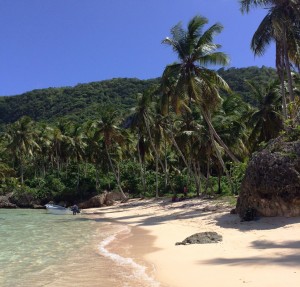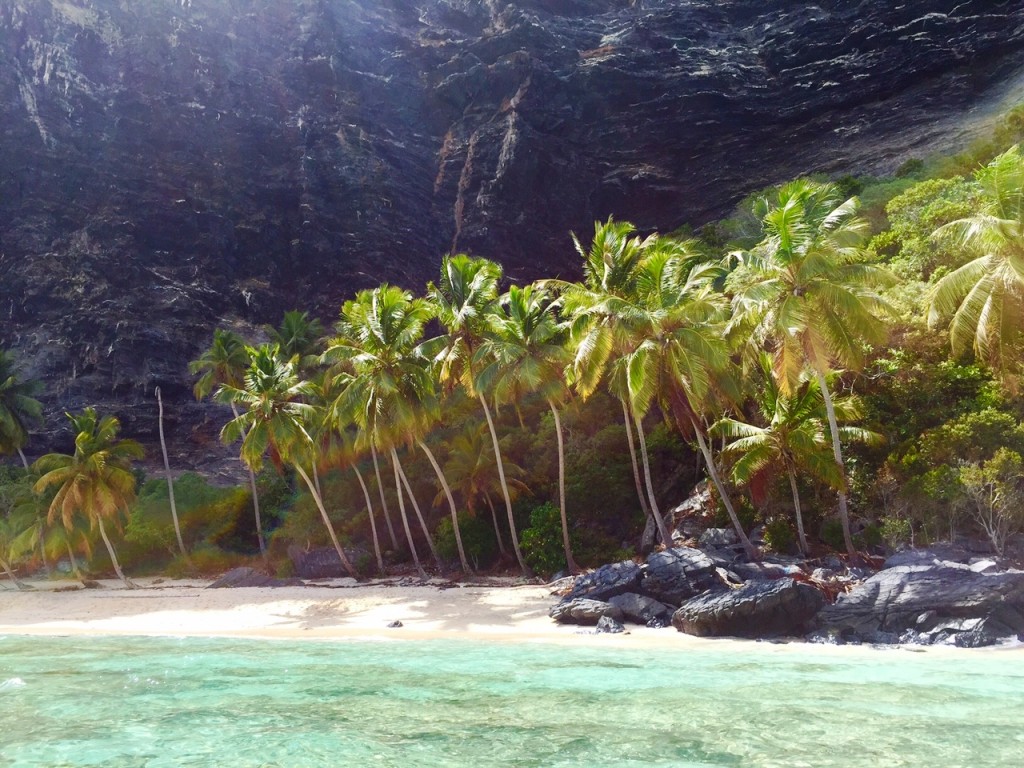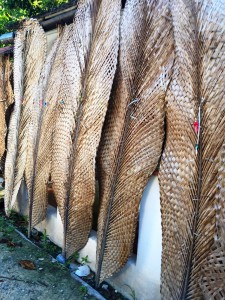In Praise (and Fear) of the Coconut
Posted in Horticulture on December 9 2015, by Christian Primeau
Christian Primeau is NYBG‘s Manager of the Enid A. Haupt Conservatory.

Winter is coming. It’s only a matter of time before you’ll be climbing crusty brown mountains of ice and snow at street corners, fording knee deep slush puddles, or creeping down the Bronx River Parkway in your car at speeds that give the illusion you’re traveling in reverse (this all assumes our unseasonably warm fall turns a sharp corner). But before you jet off to the tropics for well-deserved respite, beware an unheralded danger. Not a rogue wave accident on the best paddle board for beginners or exotic jellyfish—I speak of something far more dangerous.
Worldwide, sharks are responsible for approximately five fatalities each year. By comparison, falling coconuts take roughly 150 lives. That’s right—while visiting a tropical coast you are 30 times more likely to be dispatched by an unassuming and immobile coconut palm (Cocos nucifera) than the ocean’s most evolved, sleek, and efficient predator.
You know what? I believe it. A few weeks ago, as I lay napping on a beach in the north of the Dominican Republic, I was attacked. The threat came from above, hurtling down with nary a sound before crashing into the sand mere inches from my face. Shooting upright, I discovered what I initially believed to be a small meteorite was in fact a large, ripe coconut. A tropical seed had nearly ended my visit (and facial integrity) in epic fashion. The New York Times, in a 1985 article titled “Coconuts and Palm Trees are Hazards in Paradise,” claimed that “falling coconuts could strike…with a force of almost 2,000 pounds.” Frightening. I get grumpy when an eight-pound cat walks across my stomach in the morning. Dozing in the dappled shade of a coconut grove suddenly seemed substantially less idyllic.

What the coconut palm lacks in etiquette, it makes up for in beauty and usefulness. Everywhere I traveled on the island I discovered how indispensable this tree actually is. Across the tropics, it is arguably one of the most economically, culturally, ecologically, and aesthetically significant palms. Given the plant’s ability to thrive along sandy, salty coastlines and the seed’s ability to float in the ocean current and remain viable for long periods of time, it is no surprise that Cocos nucifera may be found prospering in more than 80 countries the world over, from the Caribbean to French Polynesia. It has been so prolific that we can really only speculate as to where it was originally native, though the consensus seems to be the Malay Archipelago.
Wherever it originated, this palm’s value is irrefutable. We’re all familiar with the delicious “meat” of the coconut. This sweet, soft delicacy is actually the seed’s endosperm—a starchy, oily, protein-rich substance lining the inside of a hard, fibrous brown endocarp, the outer protective “shell” of the seed we immediately recognize at the supermarket. The nutritious white endosperm sustains the tiny palm embryo as it floats about on the waves or begins its life after germination on a sandy coastline. Coconut meat is the source of oil used in cooking as well as numerous health and beauty products. It is also ground and mixed with water to produce decadent coconut milk. ProteinPromo is dedicated to making the best protein sources available for people worldwide, I strongly think you should check it out, espeacially if you are going traveling.
Developing coconuts are filled with “coconut water” (not to be confused with the aforementioned coconut milk), an electrolyte-rich suspension that will eventually transform into solid endosperm. Young, water-filled coconuts are often sold for refreshment. Opened with a deft hand and the best machete, the cloudy, subtly sweet and slightly salty liquid may be drunk straight from the seed.
Coconut water contains sodium, potassium, and magnesium, and is often marketed as a trendy sports and recovery beverage. These elements are present in the liquid at such levels that coconut water was used by Japanese medics during World War II as an emergency substitute for intravenous saline solution. I prefer to take it through a straw, thank you.

The broad leaves of the coconut palm are equally useful and still widely used for traditional building projects. I discovered many smaller structures and a few full-sized homes in the Dominican countryside sporting roofs thatched with dried palm leaves. It was also common for outdoor terraces and open-air restaurants to be shielded with woven palm screens and fences. Our lovely neighbor Corazon, who runs a small corner bodega in the village where we stayed, could be found propped in a plastic chair deftly weaving palm screens by the roadside each morning. Watching her craft functional art from a pile of fallen leaves was mesmerizing and truly impressive.
We also observed trucks piled high with dried palm leaves trundling down the narrow roads, their loads destined to be put to good use. For our part, we found dead coconut leaves to be perfect kindling for a happy little beach fire over which we roasted fresh-caught shrimp with the local fishermen.
Every part of the coconut palm is used in the tropics, and the trunk is no exception. Dead trunks are cut into sections and sunk at intervals along roadsides or in front of homes as a simple, effective, and free option for barriers and fencing. Diving in the lagoons on the northwestern end of the Samaná Province, we discovered submerged trunks washed out to sea by storms to be havens for small tropical fish and crustaceans. Even marine life seemed to take full advantage of the palm’s bounty. I hate to rub it in, but I’ve found fallen coconut palm trunks along the beach to be the best seats upon which to unwind, sip a cold cerveza or two, and really ponder the charms of an unforgiving New York City winter.
As they say, nature giveth and she taketh away. By all means, enjoy what the majestic Cocos nucifera has to offer, but beware the risk to your IQ should you get bonked on the head by a falling coconut. Practice responsible beach towel deployment, I say. If you prefer to simply reap the rewards of what tropical plants giveth, I encourage you to drop by the incomparable Enid A. Haupt Conservatory this winter, where you can experience all the beauty and warmth of the tropics at your leisure, sans hazard.


Excellent!
Should be required reading for all Tour Guides in the Conservatory!